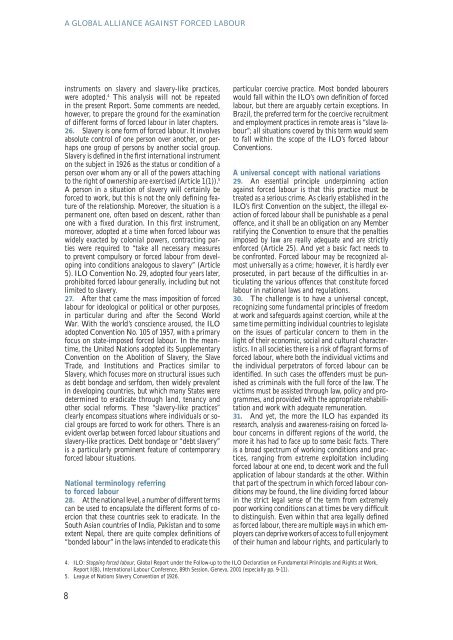A Global Alliance Against Forced Labour - International Labour ...
A Global Alliance Against Forced Labour - International Labour ...
A Global Alliance Against Forced Labour - International Labour ...
You also want an ePaper? Increase the reach of your titles
YUMPU automatically turns print PDFs into web optimized ePapers that Google loves.
A GLOBAL ALLIANCE AGAINST FORCED LABOURinstruments on slavery and slavery-like practices,were adopted. 4 This analysis will not be repeatedin the present Report. Some comments are needed,however, to prepare the ground for the examinationof different forms of forced labour in later chapters.26. Slavery is one form of forced labour. It involvesabsolute control of one person over another, or perhapsone group of persons by another social group.Slavery is defined in the first international instrumenton the subject in 1926 as the status or condition of aperson over whom any or all of the powers attachingto the right of ownership are exercised (Article 1(1)). 5A person in a situation of slavery will certainly beforced to work, but this is not the only defi ning featureof the relationship. Moreover, the situation is apermanent one, often based on descent, rather thanone with a fi xed duration. In this first instrument,moreover, adopted at a time when forced labour waswidely exacted by colonial powers, contracting partieswere required to “take all necessary measuresto prevent compulsory or forced labour from developinginto conditions analogous to slavery” (Article5). ILO Convention No. 29, adopted four years later,prohibited forced labour generally, including but notlimited to slavery.27. After that came the mass imposition of forcedlabour for ideological or political or other purposes,in particular during and after the Second WorldWar. With the world’s conscience aroused, the ILOadopted Convention No. 105 of 1957, with a primaryfocus on state-imposed forced labour. In the meantime,the United Nations adopted its SupplementaryConvention on the Abolition of Slavery, the SlaveTrade, and Institutions and Practices similar toSlavery, which focuses more on structural issues suchas debt bondage and serfdom, then widely prevalentin developing countries, but which many States weredetermined to eradicate through land, tenancy andother social reforms. These “slavery-like practices”clearly encompass situations where individuals or socialgroups are forced to work for others. There is anevident overlap between forced labour situations andslavery-like practices. Debt bondage or “debt slavery”is a particularly prominent feature of contemporaryforced labour situations.National terminology referringto forced labour28. At the national level, a number of different termscan be used to encapsulate the different forms of coercionthat these countries seek to eradicate. In theSouth Asian countries of India, Pakistan and to someextent Nepal, there are quite complex definitions of“bonded labour” in the laws intended to eradicate thisparticular coercive practice. Most bonded labourerswould fall within the ILO’s own definition of forcedlabour, but there are arguably certain exceptions. InBrazil, the preferred term for the coercive recruitmentand employment practices in remote areas is “slave labour”;all situations covered by this term would seemto fall within the scope of the ILO’s forced labourConventions.A universal concept with national variations29. An essential principle underpinning actionagainst forced labour is that this practice must betreated as a serious crime. As clearly established in theILO’s first Convention on the subject, the illegal exactionof forced labour shall be punishable as a penaloffence, and it shall be an obligation on any Memberratifying the Convention to ensure that the penaltiesimposed by law are really adequate and are strictlyenforced (Article 25). And yet a basic fact needs tobe confronted. <strong>Forced</strong> labour may be recognized almostuniversally as a crime; however, it is hardly everprosecuted, in part because of the difficulties in articulatingthe various offences that constitute forcedlabour in national laws and regulations.30. The challenge is to have a universal concept,recognizing some fundamental principles of freedomat work and safeguards against coercion, while at thesame time permitting individual countries to legislateon the issues of particular concern to them in thelight of their economic, social and cultural characteristics.In all societies there is a risk of flagrant forms offorced labour, where both the individual victims andthe individual perpetrators of forced labour can beidentified. In such cases the offenders must be punishedas criminals with the full force of the law. Thevictims must be assisted through law, policy and programmes,and provided with the appropriate rehabilitationand work with adequate remuneration.31. And yet, the more the ILO has expanded itsresearch, analysis and awareness-raising on forced labourconcerns in different regions of the world, themore it has had to face up to some basic facts. Thereis a broad spectrum of working conditions and practices,ranging from extreme exploitation includingforced labour at one end, to decent work and the fullapplication of labour standards at the other. Withinthat part of the spectrum in which forced labour conditionsmay be found, the line dividing forced labourin the strict legal sense of the term from extremelypoor working conditions can at times be very difficultto distinguish. Even within that area legally definedas forced labour, there are multiple ways in which employerscan deprive workers of access to full enjoymentof their human and labour rights, and particularly to4. ILO: Stopping forced labour, <strong>Global</strong> Report under the Follow-up to the ILO Declaration on Fundamental Principles and Rights at Work,Report I(B), <strong>International</strong> <strong>Labour</strong> Conference, 89th Session, Geneva, 2001 (especially pp. 9-11).5. League of Nations Slavery Convention of 1926.8
















